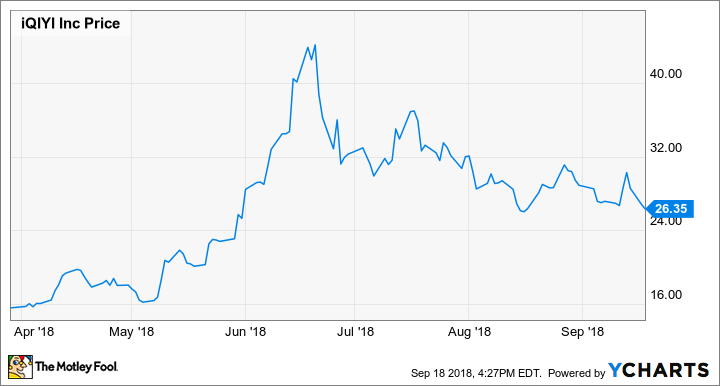iQiyi (IQ 0.52%) has proven to be an exciting and somewhat controversial stock since being spun off from Baidu (BIDU +0.02%) at the end of March. The video-streaming company's share price dipped out of the gate, but it quickly recovered -- climbing from an IPO priced at $18 per share to as high as $46 in June. Shares are now down roughly 40% from that all-time high and have been bouncing around the $28 range over the last month as the market attempts to shake out what's next for the Chinese video company.
With some of the post-IPO shine appearing to have worn off and bears weighing in with concerns about the company's rapidly expanding operating costs and tough competition from Tencent Holdings and Alibaba, it's not unreasonable to be skeptical about iQiyi. It's far removed from being a low-risk investment, and there are a lot of unknown variables that will shape performance going forward. However, some key points of the bearish thesis appear to be wrong or overstated.

Images: Getty Images.
Trade disputes aren't a huge problem for iQiyi
Chinese tech stocks have seen their valuations cut down in light of heightened trade tensions between the U.S. and China, and iQiyi has been among those affected. The chart below tracks iQiyi's stock price over the last three months against the change in the Invesco China Technology ETF:
This chart suggests that iQiyi's stock is trading in close correlation with the country's broader tech sector. However, iQiyi's business is largely focused on building its content platform in its domestic market. To the extent that the business is pursuing distribution in other countries, it's mostly looking at other Asian markets, and deals that it signs with Western entertainment companies aren't likely to be subject to tariffs or other new regulations. iQiyi's business looks less vulnerable to trade issues than many others in its sector.
If the issues mount or continue without resolution over the long term, it's reasonable to expect that China's overall economic growth could slow and that this would have an impact on iQiyi. However, unless the recent trade tensions escalate enough to dramatically damage the Chinese economic growth engine, it seems unlikely that trade issues will play a defining role in shaping the company's future. Entertainment industries tend to be resilient, even during downturns, and iQiyi should be able to weather some turbulence if it comes.
The competition isn't insurmountable
iQiyi bears are right that the company faces tough competition from resource-rich competitors. Tencent Video and Alibaba's Youku Tudou will remain long-term players in the streaming industry, but iQiyi's close relationship with Baidu and access to its data and artificial intelligence resources mean that the smaller company is not as outgunned as it appears. In addition, growth for the Chinese consumer economy suggests that the market can support multiple successful platforms.
Just as Netflix (NFLX 0.33%) provides a rough blueprint for what iQiyi is trying to do, the American video market provides a window into what the future of the Middle Kingdom's streaming industry might look like. While explaining the outlook for his company's upcoming streaming platform in a recent earnings call, Disney CEO Bob Iger pointed out that more than half of U.S. households pay for a streaming video service -- and these households subscribed to three different products on average. It's reasonable to expect that the Chinese market could see similar consumer behavior. With eMarketer estimating that somewhere around 229 million out of roughly 1.4 billion people in the country will have a subscription video service in 2018, there's still huge room for growth.
Cooperation among China's three streaming video leaders to keep content production costs down suggests that the companies do not have a "winner take all" view of the market. Demand for hit content is driving up production costs, but iQiyi, Tencent, and Alibaba recently agreed to a pledge that will see actors' salaries capped at no more than 40% of a project's cost. Six other production companies also signed on to the proposal, and the Chinese government has itself evidenced willingness to implement measures to keep entertainment production costs down.
Subscriptions to streaming video services should continue to climb as over-the-top distribution becomes more popular and more Chinese citizens become middle class. IHS Markit estimates the streaming industry will have grown from roughly $3.2 billion in 2015 to roughly $14 billion in 2020.
Of course, an expanding market alone isn't a good enough reason to write off competitive threats. Tencent has advantages because it can play off synergies with its hugely popular WeChat social media platform and because it can use its strength in video games to create an encompassing multimedia platform. Alibaba can integrate its video platform with its e-commerce business, as Amazon has done. However, iQiyi repeatedly has shown that it has what it takes to be a winner in video content, and it also has big opportunities to expand further into product licensing, video games, and other multimedia segments.
The company's historical drama The Story of Yanxi Palace recently set a viewership record in China, with roughly 700 million views on its peak day and more than 15 billion views across the series' 70-episode run. The company produced five of China's top ten original internet variety shows, and six of the top 10 original internet dramas in 2017. So long as its platform has appealing content at a reasonable price, iQiyi should be able to keep winning in streaming video and building out from there. Things look promising on that front.
iQiyi's valuation isn't prohibitive in context
iQiyi is on track to do roughly $3.7 billion in revenue this year, which means the company trades at roughly 5 times expected sales. For comparison, Netflix has a forward P/S value of roughly 10. The American company is already profitable, an important distinction, but it trades at roughly 138 times this year's expected earnings , so it's not as though the stock looks super cheap based purely on its price-to-earnings ratio.
Investors should keep in mind that iQiyi started out in 2010 as a loss-leader for Baidu, focused on expanding the parent company's ecosystem through a free, ad-supported service. It's much earlier along in its push to build paid subscriber rolls. Accomplishing this means spending money. Second-quarter operating losses increased from roughly $150 million in 2017 to roughly $200 million this year, but expanding losses at this stage aren't gravely concerning as the company bolsters its content offerings to move toward a more subscription-focused business.
The company has managed to increase its paying user base from roughly 5 million subscribers in May 2015 to roughly 67 million at the end of June this year. That's impressive growth, although some critics will point out iQiyi's relatively low average revenue per user (ARPU).
Dividing the company's roughly $374 million in second-quarter member services revenue by subscriber numbers suggests that the company generated about $5.60 for each of its paid members over the period -- or about $1.87 a month. That's well-below what a service like Netflix is bringing in, and bears might use this to make the case that iQiyi is overvalued in general, or relative to the American streaming leader. I think that reasoning ignores long-term potential in light of current trends.
China's middle class is expanding rapidly, and this trend is helping the country's entertainment industry post growth that far outstrips what's being seen in most other major economies. iQiyi isn't focused on ARPU at the moment and is instead prioritizing widening the platform's customer base. That's an approach that makes a lot of sense at present. Per household discretionary spending is still well below U.S. levels, but it's on track to rise rapidly over the coming decades -- with analysis from McKinsey estimating that the category will have grown at a compound annual rate of 7.6% from 2013 to 2030.
iQiyi also currently generates more sales from its ad-supported model than subscriptions, so focusing on low ARPU on the subscriber side doesn't give the whole picture. The goal is to change that and have subscriptions and other transactions drive growth, but for now, the company's "wide-net" model looks to be the right one, and it has the potential to pay off in a big way as China continues to develop and sees more of its citizens enter the middle class.










